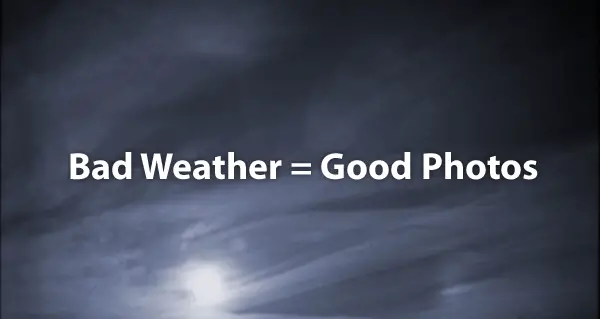If you have a photo camera (DSLR or a film one) then you’ve definitely took photos outdoors at least once, twice or even regularly. When capturing landscape photography or portraits you could notice that weather and lighting do matter greatly. You can take photos of the same object with a few minutes time interval and get different results.

And you know what’s the reason? Lightning! When you work in studios you are the master of lighting: you can move light poles and experiment with shadows at your liking. But when you are on the open space you can do nothing, but catch natural lighting without thinking whether it is good or bad. In fact, it is always good. It’s said that bad weather is a myth, there are only bad clothes. By the way, it concerns your photography too.
If you’re going to take landscape photos on a regular basis you should break the most popular photography stereotype that sunny weather is a good weather. A sunny noon is one of the worst times for landscape photographers. Such lighting is too strong for good photos. Moreover, there is a kinda of haze in the air that smooths over background details and reduces contrast of colors. In opposite, when the sky is covered with some clouds the entire composition looks more camera-friendly. Clouds make sun lighting more soft and moderate brightness. Thus, images become more eye-candy and attract more attention.
Now it’s autumn and more often you’ll see gray sky instead of sun rays. So when there is a bad lighting outside and the sky is covered with rainy lightproof clouds you should leave great panoramic views and accentuate your camera’s attention on smaller details. Bright lighting can conceal some color contrasts and make shades almost invisible, that’s why “bad” weather is better for more subjective shots.
But hey, you shouldn’t think that dull weather limits your creativity with colorless photos. You can always try to find bright colors (or add them to) in around nature. On a dark background juicy tones always look brighter and more impressive than on a clear sunny day. Red berries, colorful umbrellas and bright clothes can enliven your melancholy mood and landscape photography.
After all, an essential question appears: what is the best weather for taking photos? It seems strange, but a foul weather is considered to be the most preferable one. Of course, I don’t mean rainy and snowy days when nobody wants to go out of the home (but hey, why not?). I’m talking about those precious moments of changeable weather just before or after the rain. When the sun struggles through dense clouds and tears them like a wet paper you can observe fantastic pictures. If you’ve ever seen such scenes you have to know that they are quite changeable and a photographer should seize the moment to take great photos. In this situation your photography skills and experience do matter.
So here is a conclusion that the article was aimed at: spare no efforts at practice. Take as many landscape photos as you can. Hundreds of bad picture you take will reduce you to foresee lighting changes and to create really awesome landscape photos.









0 comments